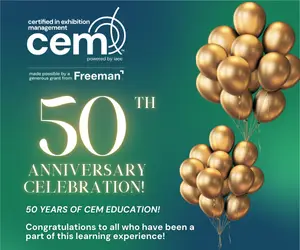
Editorial Note: Originally published in the September 2022 issue of Trade Show Executive magazine.
Many organizations are closing out their fiscal year this month, which includes forecasting what lies ahead. Executive leaders are faced with the daunting task of making decisions that include taking calculated risks, staying current on fiduciary duties, investing in the organization’s infrastructure, securing a viable reserve fund, etc. to take them through the coming year.
While no one can truly predict what to expect from outside forces, we do have enough information to work from that gives us a certain amount of confidence. Which is important because we owe our stakeholders a certain amount of security, especially our team members. Of all the things to plan for, workforce development is among the top considerations. This has always been the case to an extent, but in today’s business environment we are feeling the implication of this more than ever.
In my conversations with colleagues, the concerns surrounding strengthening the workforce is prevalent. Many companies are working with diminished staff, ranging from slight to severe. The harsh reality of just how many professionals had to leave the industry to ride out the pandemic is a challenge that top executives must overcome.
The truth of the matter is that organizational leaders are up against tough circumstances regarding recruiting and onboarding of new employees. The learning curve involved in replacing employees with 8 to 10 years of experience is significant. In addition, this is being done with smaller budgets and overloaded schedules as in-person shows continue to make their comeback.
So, let’s talk about solutions.
Our industry has done a fine job in recent years of developing the career path for young professionals within the industry. We have laid the foundation for the next step, which is to increase our outreach to the future workforce currently enrolled in high schools, community colleges and universities. We must attract the next generation of professionals by effectively communicating the vast expanse of career opportunities in our industry.
For example: I enjoy volunteering for my alma mater, Michigan State University, by serving on the board of directors of its School of Hospitality Business. Recently, I had an interesting conversation with a student majoring in finance, who was not aware of the myriad of opportunities in that specialty within the trade show industry. The same could be said about majors in business, marketing and communications, IT… you get the picture.
What is your organization doing to promote the career possibilities to those who may not realize just how formidable our industry is? According to the Center for Exhibition Industry Research (CEIR), the U.S. B2B exhibition industry contributed $76 million in business sales and $43 billion in GDP in 2021. It also supported 1.2 million jobs. Of course, these numbers are expected to rise as we continue our restoration process. We are primed to experience a level of success in the coming years that will appeal to the incoming workforce and it behooves us to make sure they know about it.
Professional development for those already in the industry is also paramount. As I noted last month, re- and up-skilling our current workforce is another priority especially as we embrace our fast-moving digital transformation. Professional certification programs are another productive way to enhance at-home and online learning pathways while maintaining the demanding work environment we are currently experiencing. Are you promoting and supporting these efforts among your staff?
This month I encourage executive leaders who are planning their fiscal year to emphasize workforce development so we can continue growing to the levels that we know we are capable of and ensure the future of our industry.
David DuBois, CMP-F, CAE, FASAE, CTA
President & CEO
IAEE


